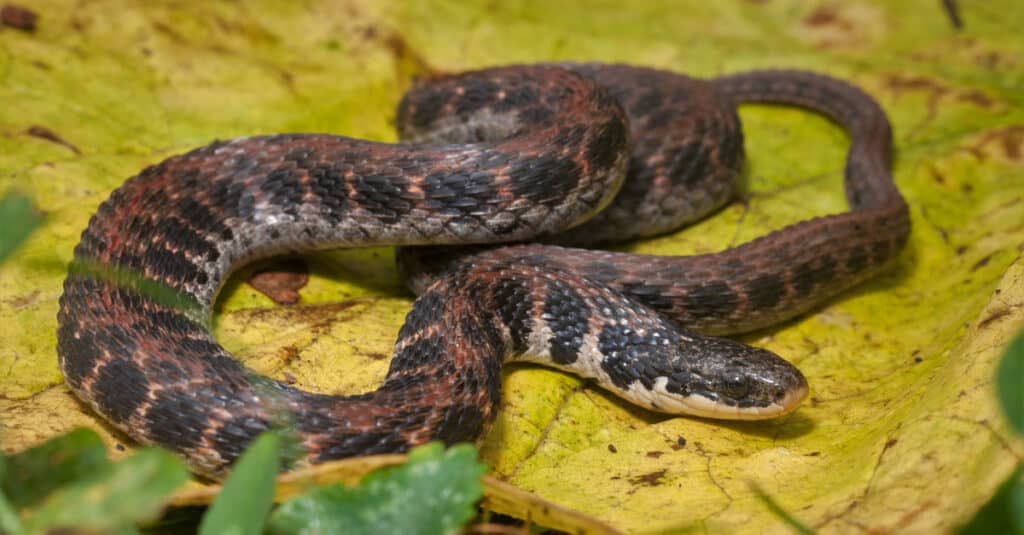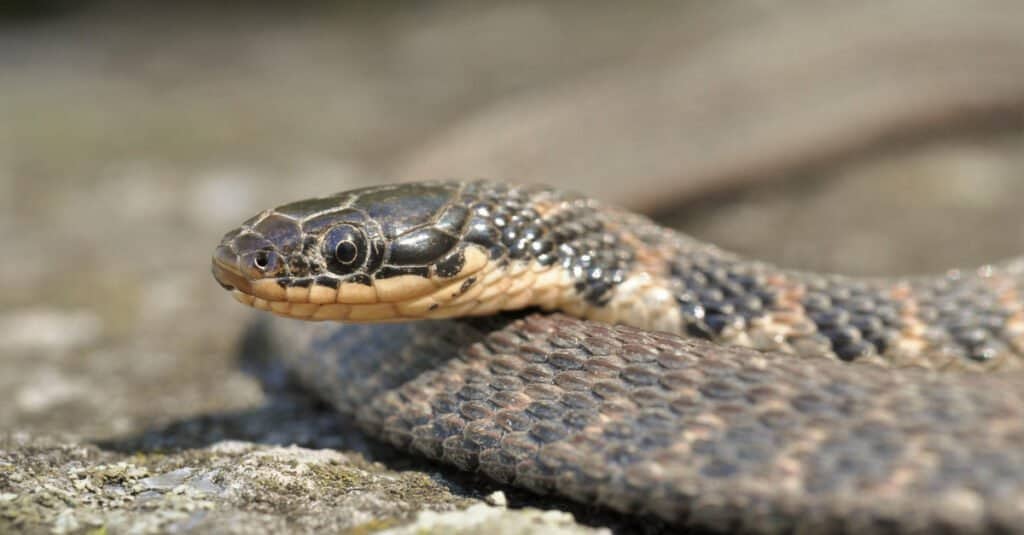Kirtland’s snake
.jumbotron {
background-image: url(“https://a-z-animals.com/media/2022/02/Kirtlands-snake-header-400×300.jpg”);
}
}
@media only screen and (min-width: 641px) and (max-width: 920px) {
.jumbotron {
background-image: url(“https://a-z-animals.com/media/2022/02/Kirtlands-snake-header-470×370.jpg”);
}
}
@media only screen and (min-width: 921px) {
.jumbotron {
background-image: url(“https://a-z-animals.com/media/2022/02/Kirtlands-snake-header.jpg”);
}
}
Kirtland’s snake
Clonophis kirtlandii
It is considered to be the least aquatic of water snakes.
Kirtland’s snake Scientific Classification
- Kingdom
- Animalia
- Phylum
- Chordata
- Class
- Reptilia
- Order
- Squamata
- Family
- Colubridae
- Genus
- Clonophis
- Scientific Name
- Clonophis kirtlandii
Read our Complete Guide to Classification of Animals.
Kirtland’s snake Conservation Status
Kirtland’s snake Facts
This post may contain affiliate links to our partners like Chewy, Amazon, and others. Purchasing through these helps us further the A-Z Animals mission to educate about the world’s species..

Discover alligator-eating snakes, spiders larger than your phone, and 1000 more incredible animals in our daily FREE email.
.photo-gallery {
–margin: 0px auto 0px;
–padding: 0px 0px 0px 0px;
}
.gallery-link {
background-image: url(“https://a-z-animals.com/media/2022/02/Kirtlands-snake-header-1024×535.jpg”);
background-repeat: no-repeat;
background-size: cover;
background-position: center;
height: 500px;
justify-content: center;
text-align: center;
align-items: center;
display: flex;
border: 2px solid #000;
}
.gallery-link img {
height: 50%;
}
@media only screen and (max-width: 768px) {
.gallery-link {
height: 300px !important;
}
}
View all of the Kirtland’s snake images!
Kirtland’s snake is a small snake, about 14-28 inches long, that inhabits areas in the north-central Midwest.
It’s frequently confused with several other snakes including Dekay’s Brown Snake and the Northern Red-bellied Snake, but its belly is what you’ll use to confirm its identity. They always live near a water source and their prey includes small reptiles, slugs, earthworms, and slugs.
Kirtland’s snake Amazing Facts!
- They can be very dramatic when threatened and might writhe around, or roll up into a ball and play dead.
- They are ovoviviparous and give live birth.
- Their belly is red, orange, or pink with dots on the sides.
Where to Find Kirtland’s snake
Kirtland’s snakes inhabit moist open meadows and wet prairie lands. They are small and reclusive and spend much of their time underground making use of crayfish burrows. They need a moist-soil environment to survive so a water source (either permanent or seasonal) is always nearby. They have also been known to find their way to the edge of developed areas. When they’re found above-ground it’s typically under moist leaf litter or another shelter because they don’t bask very often.
button.pulse {
transform: scale(1); animation: pulse 2s infinite;
box-shadow: 0 0 0 0 rgba(11, 247, 25, 1);
}
@keyframes pulse {
0% { transform: scale(0.90); box-shadow: 0 0 0 0 rgba(11, 247, 25, 0.5); }
60% { transform: scale(1); box-shadow: 0 0 0 15px rgba(11, 247, 25, 0); }
100% { transform: scale(0.90); box-shadow: 0 0 0 0 rgba(11, 247, 25, 0); }
}
They’re active from March or April to November, preying on a variety of animals such as earthworms, slugs, small reptiles, and amphibians. They are ovoviviparous and do not lay eggs and instead give birth to live young. Mating is in the spring, and young are born around August.
Kirtland’s snake Scientific Name
Their scientific name is a blend of Greek and Latinized English. Clonophis means twig snake (Klon = twig; ophios = snake), and kirtlandii refers to Dr. Jared Potter Kirtland (1793-1877) who founded the Cleveland Museum of Natural History, in whose honor the snake was named. Kirtland’s snakes are the only species in the genus clonophis.
Kirtland’s snake Population and Conservation Status
These snakes have declined dramatically over the last several decades and their IUCN status is near threatened. There is no accurate count of their population due to their reclusive and difficult-to-study nature. The greatest challenge to their population at present is habitat loss and degradation, and all the states they inhabit have listed them as either threatened or endangered.
Appearance and Description of Kirtland’s snake
Kirtland’s snakes are small, reddish to dark brown snakes. They range from 14-28 inches long and thin, and the females give birth to a clutch of 4-15 live young in late summer. Their belly is the best way to identify them: it is red, orange, or pink and has two rows of dark spots along either side. Their back has two rows of larger dark blotches and two rows of smaller dark blotches; and scales on their top side are keeled, giving a textured feel to their skin.
They are often confused with Dekay’s brown snake and Northern Red-bellied Snakes. Dekay’s brown snake looks similar on the back, but the belly is light brown, and the red-bellied snake doesn’t have as much detail in its rows of spots.
Kirtland’s snake Photos and Videos

Mike Wilhelm/Shutterstock.com

Mike Wilhelm/Shutterstock.com

Mike Wilhelm/Shutterstock.com
Are Kirtland’s snakes Dangerous?
These snakes are harmless, but try to put on a good show when they are threatened or disturbed. They flatten themselves to appear larger, stiffen up and play dead, or roll up into a ball.
Kirtland’s snake Behaviour and Humans
These snakes are rather shy, they’re not particularly brave and would rather hide than fight. They spend much of their time underground and are secretive, according to biologists. If you find one, it’s most likely to be underneath a shelter of some sort – and their idea of shelter is flexible. A cardboard box on a damp lawn or an abandoned crayfish burrow will do.
They have a number of natural predators, from burrowing animals like weasels and milk snakes; when they’re above ground hawks, cats, weasels, and skunks may prey on them.
View all 45 animals that start with K
Kirtland’s snake FAQs (Frequently Asked Questions)
Are Kirtland’s Snakes venomous?
No. These snakes are non-venomous and not dangerous to people or pets (unless your pet is a free-ranging slug or crayfish).
How do Kirtland’s snakes hunt?
These snakes are fossorial, meaning they spend a lot of time underground. They use burrows already dug by other animals and don’t dig themselves.
Are Kirtland’s snakes aggressive?
Kirtland’s snakes are very shy and will try to escape rather than fight. Their favorite defense tactic is coiling into a spot about the size of a quarter, when that fails, they flee.
Where do Kirtland’s snakes live?
You might find Kirtland’s snakes in wet grassy meadows in the north-central Midwest United States. They’re primarily found in Indiana, Illinois, Michigan, Ohio, northern Kentucky, Missouri, and a small area in Western Pennsylvania.
What do Kirtland’s snakes eat?
They feed on juvenile crayfish, earthworms, slugs, and other small amphibians & reptiles.
Sources
- Michigan State University, Available here: https://mnfi.anr.msu.edu/species/description/11499/Clonophis-kirtlandii
- PACE, Available here: https://pace.inhs.illinois.edu/amphibian-and-reptile-conservation-arc/kirtlands-snake/
- IUCN, Available here: https://www.iucnredlist.org/species/63747/12712865
















